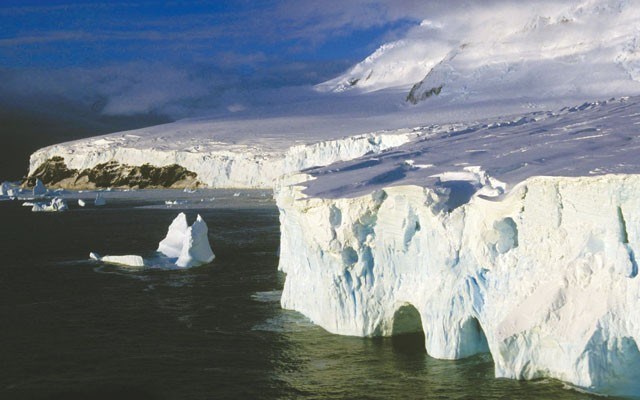What does it take to be able to call yourself the Last Place on Earth?
Grab a set of pointed dividers — the kind nautical route-plotters use — and a 1:40,000,000 map of the world (that's about a metre across — the scale of most globes). Implant one end at precisely 54°26'S, 3°24'E, set the distance between points to 1,600 kilometre on your map, and trace a circle. You'll notice your dividers have impaled a tiny piece of land, no more than a pinhead at this scale, and that within the circle you've prescribed — some 8,148,103 km2 of ocean, or 80 per cent the size of Europe — not a single additional piece of land occurs. With South Africa 2,500 km to the northeast and the nearest oceanic islands some 1,800 km removed, the closest terra firma is Queen Maud Land in Antarctica, 1,750 km south. No other place on Earth, in fact, is as peculiarly isolated as the 50 km2 sub-Antarctic speck known as Bouvet Island.
Wildly remote and wildly inhospitable, Bouvet is the top of a dormant shield volcano marking the terminus of the Mid-Atlantic Ridge, the world's longest mountain/rift system stretching nearly 10,000 km north to the Arctic Ocean. Having last erupted around 50 BC, thick glacial ice now spills out of the volcano's remnant caldera to cap 95 per cent of an island otherwise rimmed by 500-metre basalt cliffs. Ferocious winds, heavy seas, near constant mist, and a lack of any protected cove make landing on Bouvet risky if not entirely foolhardy. Fittingly and famously, it is also hard to find: discovered in 1739 by Frenchman John-Baptiste Charles Bouvet de Lozier (considered by many to be the earliest polar explorer), the island wasn't seen again until 1820 — maybe — and not for lack of looking; marked on maps and then removed from maps, when it did appear its placement often varied by hundreds of kilometres, shielding it from such luminary searchers as British mariners James Cook and James Clark Ross.
These days the island is firmly on the map, still empty, but a Norwegian protectorate called Bouvetøya. Although landings of any kind are prohibited without permission, it remains sought after by obsessive travellers. Cited as one of only two places unvisited by John Clouse, the Guinness Book of World Records' erstwhile "most traveled man," Clouse's successor to the title, Charles Veley, took 72 days to reach the island before making a sketchy helicopter landing. In the 2012 documentary Bouvetøya: The Last Place on Earth, Canadian adventurers Jason Rodi and his father Bruno journey from their home in Montreal to plant a time capsule on the island's unclimbed highest point — 780m Olavtoppen. Together, the pair had previously climbed the highest mountain on each of the seven continents, and trekked to both North and South Poles. This time they traversed the planet's roughest ocean to its remotest locale, then scaled a glacier carrying a titanium tube filled with messages of hope for the future — a symbolic journey Jason hoped would inspire humanity to do better. He also hoped his daughter would retrieve the capsule in fifty years to find Bouvetøya as free of humanity's footprint as today.
That'll be difficult in the Anthropocene — the aptly named current geological epoch of a human-altered lithosphere whose anthropogenic phenomena include climate change, ocean acidification, habitat loss, and the planet's sixth great extinction episode. Dodging all of these global guns might be impossible, but immunity from even a few could still confer a unique form of removal, one for which Bouvetøya also qualifies: its remoteness, inaccessibility, and an environment hostile to human habitation means less than 100 souls have ever stood upon it, the reason it also appears to be the last territory on the planet untouched by invasive species. As the only jurisdiction with no record of introduced flora or fauna, Bouvetøya's unheralded natural state makes it a genuine Last Place on Earth. In addition to indigenous seal, penguin and seabird species, there are only the familiar terrestrial occupants of other (now heavily invaded) sub-Antarctic islands — moss, liverworts, lichens, and tiny terrestrial arthropods like mites and springtails.
The contemporary story of Bouvetøya's isolation (and non-invasion) is noteworthy for being the only such tale you and I will ever know. It also makes for a critical experiment — the only place where all-out prevention can been enacted prior to any non-human introductions. Infrequent visitation by Norwegian scientists and tour operators requires vacuuming and bleaching of all equipment to ensure no seeds, spores, bacteria, viruses or insects are transported on or off. How long such virtual fortification can last until a wayward propagule of some organism sneaks through, however, is anyone's guess.
The only way to truly manage the Last Place on Earth would be to shield it entirely from humans — by taking it off the map again.
Leslie Anthony is a Whistler-based author, editor, biologist and bon vivant who has never met a mountain he didn't like.




